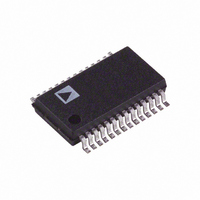AD7701ARS Analog Devices Inc, AD7701ARS Datasheet - Page 8

AD7701ARS
Manufacturer Part Number
AD7701ARS
Description
IC ADC 16BIT LC2MOS MONO 28-SSOP
Manufacturer
Analog Devices Inc
Datasheet
1.AD7701ARZ.pdf
(20 pages)
Specifications of AD7701ARS
Rohs Status
RoHS non-compliant
Number Of Bits
16
Sampling Rate (per Second)
4k
Data Interface
Serial
Number Of Converters
1
Power Dissipation (max)
37mW
Voltage Supply Source
Analog and Digital, Dual ±
Operating Temperature
-40°C ~ 85°C
Mounting Type
Surface Mount
Package / Case
28-SSOP (0.200", 5.30mm Width)
Available stocks
Company
Part Number
Manufacturer
Quantity
Price
Part Number:
AD7701ARS
Manufacturer:
ADI/亚德诺
Quantity:
20 000
Company:
Part Number:
AD7701ARSZ
Manufacturer:
MICROCHIP
Quantity:
1 000
AD7701
Offset Calibration Range
In the system calibration modes (SC2 low), the AD7701 cali-
brates its offset with respect to the A
range specification defines the range of voltages, expressed as a
percentage of V
rately calibrate offset.
Full-Scale Calibration Range
This is the range of voltages that the AD7701 can accept in the
system calibration mode and still correctly calibrate full scale.
Input Span
In system calibration schemes, two voltages applied in sequence
to the AD7701’s analog input define the analog input range.
The input span specification defines the minimum and maxi-
mum input voltages from zero to full scale that the AD7701 can
accept and still accurately calibrate gain. The input span is
expressed as a percentage of V
GENERAL DESCRIPTION
The AD7701 is a 16-bit A/D converter with on-chip digital
filtering, intended for the measurement of wide dynamic range,
low frequency signals such as those representing chemical,
physical, or biological processes. It contains a charge-balancing
(sigma-delta) ADC, calibration microcontroller with on-chip
static RAM, clock oscillator, and serial communications port.
The analog input signal to the AD7701 is continuously sampled
at a rate determined by the frequency of the master clock, CLKIN.
A charge-balancing A/D converter (sigma-delta modulator)
converts the sampled signal into a digital pulse train whose duty
cycle contains the digital information. A six-pole Gaussian digi-
tal low-pass filter processes the output of the modulator and
updates the 16-bit output register at a 4 kHz rate. The output
data can be read from the serial port randomly or periodically at
any rate up to 4 kHz.
ANALOG
SUPPLY
+5V
Figure 7. Typical System Connection Diagram
CALIBRATE
0.1µF
GROUND
ANALOG
ANALOG
ANALOG
SELECT
SUPPLY
RANGE
INPUT
–5V
REF
0.1µF
, that the AD7701 can accept and still accu-
REFERENCE
10µF
VOLTAGE
0.1µF
10µF
REF.
2.5V
IN
BP/UP
AV
CAL
A
AGND
V
AV
IN
REF
DD
pin. The offset calibration
SS
AD7701
CLKOUT
SLEEP
MODE
SDATA
CLKIN
DGND
DRDY
DV
SCLK
DV
SC2
CS
DD
SS
0.1µF
READ
READY
READ
(TRANSMIT)
SERIAL
CLOCK
SERIAL
DATA
0.1µF
–8–
The AD7701 can perform self-calibration using the on-chip
calibration microcontroller and SRAM to store calibration
parameters. A calibration cycle may be initiated at any time
using the CAL control input.
Other system components may also be included in the calibra-
tion loop to remove offset and gain errors in the input channel.
For battery operation, the AD7701 also offers a standby mode
that reduces idle power consumption to typically 10 µW.
THEORY OF OPERATION
The general block diagram of a sigma-delta ADC is shown in
Figure 8. It contains the following elements:
1. A sample-hold amplifier
2. A differential amplifier or subtracter
3. An analog low-pass filter
4. A 1-bit A/D converter (comparator)
5. A 1-bit DAC
6. A digital low-pass filter
In operation, the analog signal sample is fed to the subtracter,
along with the output of the 1-bit DAC. The filtered difference
signal is fed to the comparator, whose output samples the differ-
ence signal at a frequency many times that of the analog signal
sampling frequency (oversampling).
Oversampling is fundamental to the operation of sigma-delta
ADCs. Using the quantization noise formula for an ADC:
a 1-bit ADC or comparator yields an SNR of 7.78 dB.
The AD7701 samples the input signal at 16 kHz, which spreads
the quantization noise from 0 kHz to 8 kHz. Since the specified
analog input bandwidth of the AD7701 is only 0 Hz to 10 Hz,
the noise energy in this bandwidth would be only 1/800 of the
total quantization noise, even if the noise energy were spread
evenly throughout the spectrum. It is reduced still further by
analog filtering in the modulator loop, which shapes the quanti-
zation noise spectrum to move most of the noise energy to
frequencies above 10 Hz. The SNR performance in the 0 Hz to
10 Hz range is conditioned to the 16-bit level in this fashion.
The output of the comparator provides the digital input for the
1-bit DAC, so the system functions as a negative feedback loop
that minimizes the difference signal. The digital data that repre-
sents the analog input voltage is in the duty cycle of the pulse
train appearing at the output of the comparator. It can be
retrieved as a parallel binary data-word using a digital filter.
Sigma-delta ADCs are generally described by the order of the
analog low-pass filter. A simple example of a first-order, sigma-
delta ADC is shown in Figure 9. This contains only a first-order,
low-pass filter or integrator. It also illustrates the derivation of
the alternative name for these devices: charge-balancing ADCs.
S/H AMP
SNR = (6.02 × number of bits + 1.76) dB
Figure 8. General Sigma-Delta ADC
LOW-PASS
ANALOG
FILTER
DAC
COMPARATOR
DIGITAL DATA
DIGITAL
FILTER
REV. E













